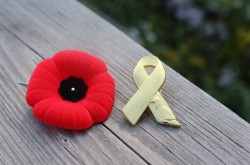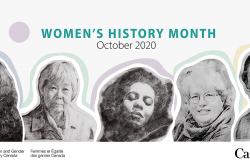Behind the scenes: Meet an Inuit chef

Trudy Metcalfe is a rare commodity; she’s the only Inuit chef in southern Canada. Far from her hometown of Nain — an Inuit community off the coast of Labrador — Metcalfe offers up a taste of her culture at various events in the Ottawa area, which she now calls home. The Ingenium Channel recently caught up with Metcalfe, just as she was preparing to serve conference delegates from around the world at the Canada Agriculture and Food Museum.

Arctic char was on the menu for international visitors at a recent event at the Canada Agriculture and Food Museum.
What are you cooking up for the delegates of the International Committee for Museums and Collections of Science and Technology?
One of the dishes is a curried caribou, so it’s an infusion dish with East Indian and Inuit country foods. As Inuit, we call our food “country food” — it’s a catch-all for food from the land or the sea. I’m also preparing maple-glazed, sesame seed-smoked Arctic char. The fish has been slow cooked at 220 F to infuse Applewood and smoke into it. The whole smoking process just adds a whole new layer to it; it’s almost a candied smoked char. It’s a cold smoke, so it hasn’t been cooked and dried out — it’s very moist.
I understand that you caught the fish yourself; tell me about that experience.
I was in Nunavut last summer, and I went Arctic char fishing with a rod for the first time ever. It was 24-hour daylight, and there were just hundreds and hundreds of char swimming by and going up to their spawning grounds. It was amazing; I can’t find the words to describe the experience. It was almost as exciting as narwhal hunting — which I also did last summer. That’s something that only Inuit do; it’s a traditional hunt. We do it for food, not for the sake of hunting. Nobody hunts or fishes for sport in Nunavut. We have sport hunters that go up there — they pay big bucks to do that — but as part of our culture we’re not sport hunters or sport fishers.

Curried caribou, prepared as an infusion dish with East Indian and Inuit country foods.
For those readers who haven’t had the chance to taste caribou, what does it taste like?
It’s a very mild meat. It’s not like moose or deer; I find moose meat to be a bit stronger. It’s a very clean-tasting meat. It’s also very lean — there’s no marbling throughout; the fat is just under the skin, it doesn’t go through the meat itself. It works very well if cooked as a stew or a curry; you can give it a quick fry or even use it in a soup.
How do you find people react to eating caribou when trying it for the first time?
Sometimes people are a little hesitant because it’s something that’s foreign to them; even though they’re in Canada — unless you’re from Newfoundland, you don’t really hear about caribou. I served caribou at the Summer Solstice Indigenous Festival in Ottawa last summer, and some parents were telling their kids it was beef to get them to eat it. But I said, “No, it’s not beef — I’m not going to pretend it’s beef!” Those who tried it kept coming back for more and more; it was quite the hit.
What do you hope people will take away from meeting you and trying your food?
I think it’s really important that people have an understanding of where the food comes from, the sustainable hunting. The outlet where I get my caribou is an inspected distribution centre from the Artic — but they buy from the local hunters, so they’re actually supporting their livelihood. I also want people to have an appreciation that Inuit do have access to extremely healthy food — probably some of the most organic foods on the face of the planet. There are so many people that are against what we do, they’re against our livelihood and our way of life.
I just wish people could understand that we’re not butchers; we’re not the people that Greenpeace tries to portray — out clubbing baby seals. The food I’m serving supports Inuit communities and hunters. This is not the sort of food you can get anywhere else in this world — you can only get it from the Arctic.
When I cook for an event, I always bring some special Inuit items with me, such as sealskin, carvings, and Inuit knives. I also sew a variation of an Inuit jacket, called silapaa. I talk about these items to educate others about our Inuit traditions, and I’m always happy to answer questions. To me, no question is a stupid question. I’d rather have people ask so I can clear up their ignorance. I don’t judge people. I’ve been judged a lot in my life, and I’m definitely not a judgemental person. I just want people to feel welcome and feel excited to try something new.

































































